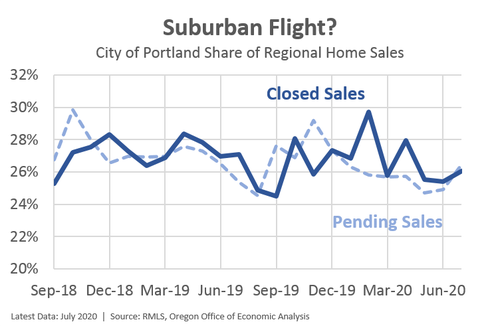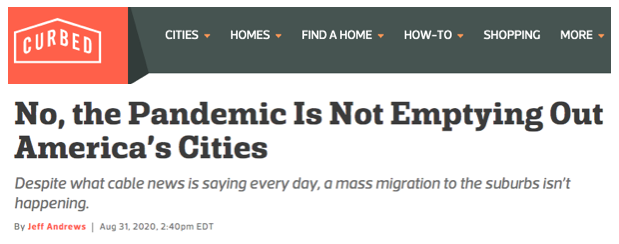Another anecdote-fueled, data-starved article repeats the “suburban flight” meme, this time for Portland.
Actual market data show the central city’s market remains strong
Janet Eastman, writing in the Portland, Oregonian, offers up yet another example of a popular journalistic trope, the “Coronavirus is triggering a flight to the suburbs.”
Never mind, of course, the point that the pandemic is just as bad, and in many cases worse in the nation’s suburbs than it is in cities, a mythical belief that density aggravates the Coronavirus is continually being repeated by journalists. We’ve pushed back against stories making this claim from The Wall Street Journal, National Public Radio, and The New York Times.
The evidence for the story consists entirely of anecdotes of two households who have recently moved from the city of Portland to one of its nearby suburbs, peppered with quotes from a handful of real estate agents about panicky buyers and bidding wars. While this make strike some observers as unusual, it isn’t. People are always moving into and out of the city from its suburbs; the movements are in both directions. So finding a handful of households moving to the suburbs can be done at any time. But it doesn’t signify a trend, or even that the movement is more in one direction rather than another.
For that, we need data. Some of the best real-time data on housing market trends comes from the web-based real estate search sites that track where people are looking for housing, and how rents and home prices are changing in response to shifting demand.
One of the biggest real estate web-sites, Zillow, just completed an extensive analysis of exactly this question: whether suburbs were seeing their market share increase at the expense of cities. They looked at data from across the nation, and their conclusion was unambiguous:
Are people fleeing the cities for greener suburban pastures? Some faint signals may have emerged in certain places, but by and large, the data show that suburban housing markets have not strengthened at a disproportionately rapid pace compared to urban markets. Both region types appear to be hot sellers’ markets right now – while many suburban areas have seen strong improvement in housing activity in recent months, so, too, have many urban areas.
Zillow’s Economic Research team analyzed a variety of Zillow data points in order to illustrate this trend. Data related to for-sale listings are generally the best indicator of real-time housing market activity, and in all but a few cases, suburban markets and urban markets have seen similar changes in activity in recent months: about the same share of homes selling above their list price, similar changes in the typical time homes spend on the market before an offer is accepted, and recent improvements in newly pending sales have been about the same across each region type.
[emphasis in original]
Of course, that’s the national pattern. What about Portland, specifically? Again, Zillow’s analysis shows that in fact, in Portland, the opposite is the case. Zillow’s data show suburban rents have decelerated by about 1.9 percent since February, but urban rents have decelerated by only about 1.1 percent, a little over half as much. Zillow’s data on home searches also shows that buyers remain even more interested in city homes relative to suburban ones than they were prior to the pandemic. And Portland followed this pattern as well, with urban searches increasing their market share relative to suburban searches in Portland at the height of the pandemic. Oregon state economist Josh Lehner points out that there’s been no shift in the city of Portland’s share of regional home sales during the pandemic.
“Urban flight” as collective journalistic hysteria
NPR’s On the Media took a close look at these stories and concluded that the “urban flight” meme is both widespread and utterly false. In an incisive article at real estate website Curbed, Jeff Andrews attributes the popularity of these stories to biases of reporters:
Given that the media industry is concentrated in Manhattan — with another good chunk in San Francisco — journalists seem to be confusing the minor outbound migration from two ridiculously expensive areas with the double dose of demand happening across the country.
More insidiously, some members of the media are willing to peddle stories about nonexistent carnage in the streets, extrapolating that the cities — all cities, but especially the diverse, Democratic–led ones — are headed for inevitable collapse. And it’s hard not to separate that dark fantasy from a Republican talking point.
But, according to the data, it’s just not happening.
The idea that the pandemic has upended real estate markets and is triggering a flood of migrants to suburbs and rural areas has enormous appeal for reporters and their editors. Anecdotes to the contrary notwithstanding, there’s virtually no data to show this is happening.
City Beat is City Observatory’s occasional feature pushing back on stories in the popular media that we think are mistakenly beating up on cities.




